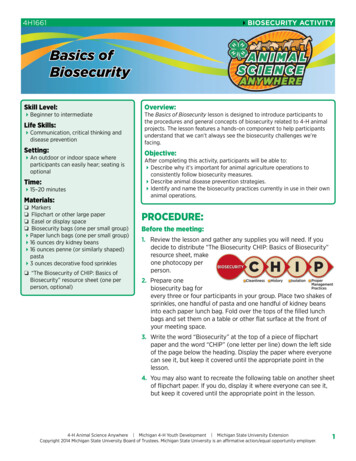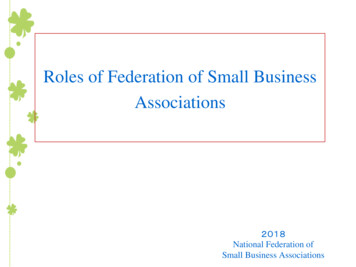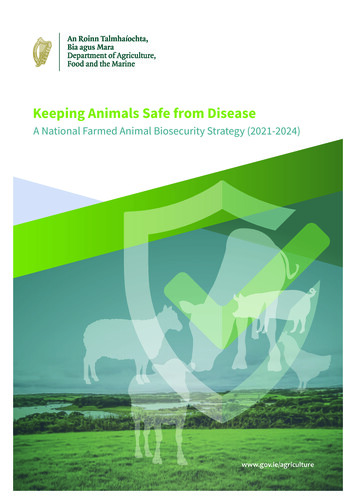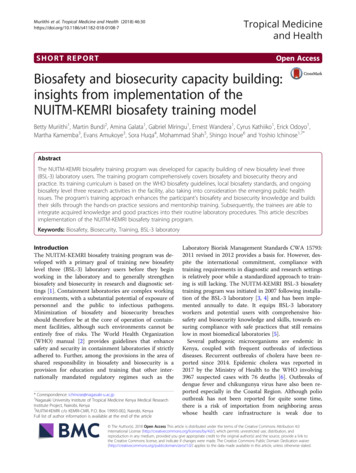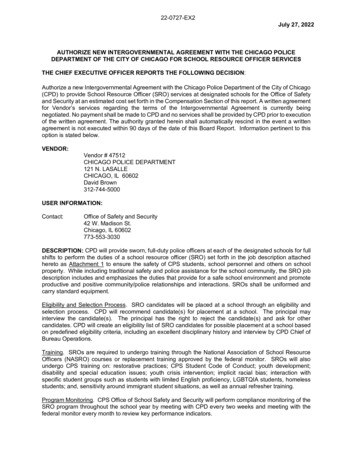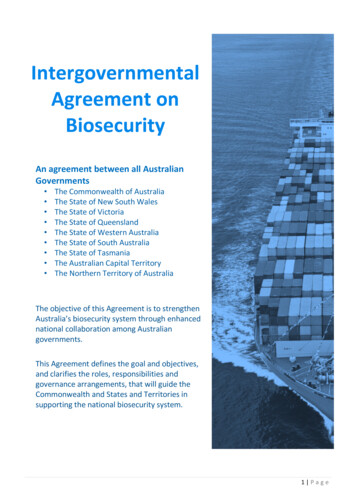
Transcription
IntergovernmentalAgreement onBiosecurityAn agreement between all AustralianGovernments The Commonwealth of AustraliaThe State of New South WalesThe State of VictoriaThe State of QueenslandThe State of Western AustraliaThe State of South AustraliaThe State of TasmaniaThe Australian Capital TerritoryThe Northern Territory of AustraliaThe objective of this Agreement is to strengthenAustralia’s biosecurity system through enhancednational collaboration among Australiangovernments.This Agreement defines the goal and objectives,and clarifies the roles, responsibilities andgovernance arrangements, that will guide theCommonwealth and States and Territories insupporting the national biosecurity system.1 Page
PRELIMINARIES1.This Agreement forms a major element of Australia’s biosecurity architecture and establishes forAustralian governments (the Parties) their commitments to strengthen, participate in and lead thenational biosecurity system by outlining the agreed goal, objectives, roles and responsibilities andgovernance arrangements.2.Australia, including its external territories, remains free from many pests and diseases that affectagriculture, natural and built environments and people in other parts of the world. This favourablebiosecurity status confers significant economic, environmental and community benefits.3.In signing this Agreement, the Parties acknowledge that sustained and coordinated action is necessaryto maintain Australia’s favourable national biosecurity status.4.The Parties support a whole-of-government approach to biosecurity, covering areas including trade,agriculture, forestry, fisheries, tourism, the environment, social amenity and human health.5.This Agreement describes the national biosecurity system primarily for animal, plant and environmentalpests and diseases in aquatic (freshwater, estuarine and marine) and terrestrial environments andecosystems, including pest animals, weeds, fungi and diseases naturally transmitted by and betweenvertebrate and invertebrate animals and humans. This Agreement does not apply to major animal-bornediseases of humans such as malaria that are primarily managed by Australian and international healthagencies.6.The Parties recognise that biosecurity is a responsibility shared by all Australians and that cooperation,investment and action with industry and the community are essential for a strong national biosecuritysystem. Governments’ agreements and arrangements with industry and the community are separatebut related to this Agreement.7.Biosecurity management is a complex task and Australia's biosecurity system will need to respond toincreasing challenges that are changing its risk profile, including:a. a changing climate altering the range, habitat and spread of pests and diseases, and increasingseverity and frequency of extreme weather events that assist spread of, and increase thesusceptibility of, plants, animals and humans to pests and diseasesb. globalisation increasing the volume and range of products traded internationally, passengermovements and the subsequent risk of pests and diseases entering and establishing in Australiac. population spread, shifting demographics and changing land uses increasing the interface betweenurban and rural areas and the natural environment, making pest and disease management morecomplicated and increasing the risk of zoonoses impacting on human health.8.Implementation and ongoing management of this Agreement will occur in conjunction with, and becomplementary to, other agreements and arrangements in place to manage biosecurity, which includeagreements and arrangements for human biosecurity and national security.
PART 1 THE NATIONAL BIOSECURITY SYSTEM — FOUNDATIONSBiosecurity9.Biosecurity is the management of risks to the economy, the environment and the community, of pestsand diseases entering, emerging, establishing or spreading.10. Australia has obligations under international agreements, including the World Trade Organization,which, among other things, binds members to comply with their obligations under the Agreement onthe Application of Sanitary and Phytosanitary Measures (the SPS Agreement) and the Convention onBiological Diversity.Biosecurity in Australia11. Australia’s biosecurity system and favourable biosecurity status confers significant benefits including:a. enhanced domestic and international trade, with access to markets with specific entryrequirementsb. assurance that safe and healthy produce is readily available to domestic and internationalconsumersc. status as a desirable and rewarding destination for tourists and other visitorsd. protection of our unique, diverse and flourishing native flora and faunae. human health and social amenity.Key biosecurity principles12. Biosecurity is a shared responsibility between all system participants.13. In practical terms, zero biosecurity risk is unattainable.14. Biosecurity investment prioritises the allocation of resources to the areas of greatest return, in terms ofrisk mitigation and return on investment.15. Biosecurity activities are undertaken according to a cost-effective, science-based and risk-managedapproach.16. Governments contribute to the cost of risk management measures in proportion to the public goodaccruing from them. Other system participants contribute in proportion to the risks created and/orbenefits gained.17. System participants are involved in planning and decision making according to their roles,responsibilities and contributions.18. Decisions governments make in further developing and operating our national biosecurity systemshould be clear and, wherever possible, made publicly available.19. The Australian community and our trading partners should be informed about the status, quality andperformance of our national biosecurity system.20. Australia’s biosecurity arrangements comply with its international rights and obligations and with theprinciple of ecologically sustainable development.Goal and objectives21. The goal of the national biosecurity system is to minimise adverse impacts of pests and diseases onAustralia’s economy, environment and the community while facilitating trade and the movement ofplants, animals, people and products.22. The objectives of the national biosecurity system are to provide arrangements, structures andframeworks involving governments, industry and community that:3 Page
a. reduce the likelihood of exotic pests and diseases which have the potential to cause significant harmto the economy, the environment, and the community (people, animals and plants) from entering,becoming established or spreading in Australiab. prepare and allow for effective responses to, and management of, exotic and emerging pests anddiseases that enter, establish or spread in Australiac. ensure that, where appropriate, nationally significant pests and diseases already in Australia arecontained, suppressed or managed by relevant stakeholdersd. enable international and domestic market access and tourism.Components of the system23. The national biosecurity system encompasses the full range of activities undertaken by all participants,of which key components include:a. one Appropriate Level of Protection (ALOP)b. national lists of exotic priority pests and diseases (for animals, plants and the environment andcommunity)c. risk analysis systemd. offshore, border and interstate inspection and assessment processese. national surveillance and diagnostic systemsf.national emergency preparedness, response and recovery arrangementsg. national reporting and assurance arrangementsh. national performance standardsi.regulatory and operational systemsj.a national information and intelligence systemk. communication and engagement arrangementsl.nationally coordinated priority researchm. national traceability systems.4 Page
PART 2 FORMALITIESParties to the Agreement24. This Agreement is between the Commonwealth of Australia (the Commonwealth) and the States andTerritories, hereafter the Parties.Whole-of-government arrangements25. In recognition of a whole-of-government approach to biosecurity, each Party will identify a ministerresponsible for biosecurity matters (Responsible Minister), the lead agency responsible for biosecuritymatters (Lead Agency), supporting minister/s and any supporting agency/ies. Parties must notify eachother of any changes.26. Within each Party’s jurisdiction, each Party will ensure there are appropriate arrangements between aLead Agency and any supporting agencies, defining the relationship, roles and responsibilities of eachagency, including the necessary information flows, deliverables and resources.Governance27. Implementation and administration of this Agreement will be through the Commonwealth, state andterritory Responsible Ministers in consultation with other relevant ministers, including first ministers.28. This Agreement:a. recognises that biosecurity is a shared responsibility and sets out the principles that will underpinthe operation of a national biosecurity systemb. describes the key components of the national biosecurity system, primarily for animal, plant andenvironmental pests and diseases in both aquatic and terrestrial environments—including zoonoticdiseases. Human biosecurity arrangements not covered under this Agreement are covered byexisting arrangements between governmentsc. clarifies the respective roles and responsibilities of the Parties in the national biosecurity systemd. describes steps to strengthen the working partnership between the Parties and to enable biosecuritymeasures to be implemented consistently and efficiently across the biosecurity continuume. establishes nationally agreed approaches for the Parties to work together to prevent, prepare for,detect and mitigate biosecurity risks, and respond to, manage and recover from biosecurity incidentsshould they occurf.identifies national priorities that the Parties will work on collaboratively to strengthen the nationalbiosecurity system.29. This Agreement constitutes and authorises the National Biosecurity Committee (the Committee) toprovide the strategic management and oversight of the national biosecurity system andintergovernmental relationships, and the operation of this Agreement. Each Party will be represented bya Lead Agency senior official, who must present a whole-of-government perspective for that Party.30. The Committee will report to the Agriculture Senior Officials Committee (AGSOC), which in turn willreport to the Agriculture Ministers’ Forum (AGMIN), the meeting of Responsible Ministers.5 Page
PART 3 COMMITMENTS OF THE PARTIES31. This Agreement recognises that the Parties have some roles and responsibilities that rest solely within asingle jurisdiction, where agreement from the other jurisdictions is not required, some will beimplemented following intergovernmental consultation, and others will be delivered in partnership.32. The Parties recognise the foundation of institutional relationships and arrangements betweengovernments and the agricultural sector is already well developed. This Agreement will build on theseand strengthen arrangements with other industries, the environmental sector, and the broadercommunity.Core commitments of the Parties33. Each Party commits to:a. adhering to and consistently applying the key biosecurity principles (above)b. maintaining Australia’s biosecurity status, recognising its benefits and protectionsc. a nationally consistent approach to system activities, measures and componentsd. fulfilling, financially resourcing to maintain an effective biosecurity system and being accountablefor their commitments under this Agreement and emergency response deeds and agreementse. sharing responsibility for biosecurity with others as appropriate, including facilitatingpartnerships between governments, industries and the communityf.sharing biosecurity information, data, intelligence and other knowledge necessary for theefficient functioning of the national biosecurity system with other Parties and, whereappropriate, with industry and the communityg. managing national priority pests and diseases (aquatic and terrestrial) under a Party’sresponsibilityh. ongoing stakeholder engagement and communication, and partnership buildingi.further developing and continuously improving the national biosecurity system within theirjurisdiction and in partnership with other Parties, recognising that the rate of progress will becontingent on available resources.Responsibilities of the Commonwealth34. In addition to the responsibilities of all Parties (above), the Commonwealth will take responsibility for:a. matters relating to the national border, including development and enforcement of quarantine andresponding to and controlling detections of exotic pests or diseases that have passed through bordercontrols and are directly related to an imported good or a container carrying an imported goodb. providing national leadership for strategic biosecurity issues, including responses to exotic pests anddiseases and management of nationally significant established pests and diseasesc. providing legislative, capacity and capability support to States and Territories, as required, to ensurethe effective management of biosecurity risksd. assessing potential risks associated with imported goods and conveyances, including leading thedevelopment of, in consultation with the States and Territories, biosecurity import risk analyses andconsidering regional differences in pests and disease status and other risk factorse. managing international government-to-government relations, including negotiating and facilitatinginternational trade and market access and certifying associated sanitary and phytosanitaryconditionsf.monitoring and reporting Australia’s pest and disease status to meet international obligations andrequests from international trading partners and other international bodiesg. incorporating biosecurity risks into threat abatement plans and recovery plans for threatened speciesand ecological communities6 Page
h. consulting with the States and Territories on the articulation of Australia’s ALOP, priorities for marketaccess requests and biosecurity import risk analyses, including through the Primary IndustriesTechnical Market Access and Trade Development Task Group (or successor bodies)i.fulfilling Australia’s obligations under international agreements and strategiesj.biosecurity activities and arrangements in relation to land for which they are responsible.Responsibilities of the States and Territories35. In addition to the responsibilities of all Parties (above) the States and Territories will take responsibilityfora. biosecurity within their borders, includingi.enforcement actions and regulatory interventionsii.managing eradication and containment programs for nationally agreed and other pest anddisease incursionsiii.undertaking surveillance and diagnostics to support early detection and diagnosisiv.biosecurity activities on public lands under their jurisdiction and, under certaincircumstances, on private landsv.regulating the keeping and movement of plants and animals that pose significant risksvi.monitoring pest and disease status, including to assist the Commonwealth meet domesticand international obligations.b. supporting the Commonwealth in international trade and market access negotiations and requestsfor information from trading partnersc. negotiating and facilitating domestic trade that is consistent with international obligations and inaccordance with clauses 36 to 38d. maintaining capacity to prepare for, detect and respond to exotic pest and disease incursionse. supporting landholders and the community to manage established pests and diseasesf.maintaining and administering systems to support agreed national traceability requirements.Interstate trade responsibilities36. The Parties agree to apply interstate biosecurity measures only to the level necessary to mitigate risks tothe economy, environment and the community. Such measures will be the least trade restrictive possible,based on science, applied only to the extent necessary to achieve Australia’s ALOP and harmonisedwhere possible. The States and Territories will accept alternative interstate biosecurity measures wherethey achieve equivalent biosecurity risk reductions.37. Subject to scientific evidence, the Parties support the development and maintenance of regional pestand disease status. The Parties will consult and notify each other on the implementation of any changedmeasure.38. Where an interstate trade dispute arises between the Parties, the relevant Parties will seek to resolvethe dispute through a process agreed by the Parties, and include determination on whether appropriateprinciples and processes were applied in imposing a biosecurity measure.Biosecurity emergency declaration powers39. The States and Territories support the use of the Commonwealth’s power to make a biosecurityemergency declaration in circumstances where these powers are necessary to prevent or control theestablishment or spread of a pest or disease.a. Parties acknowledge that, in accordance with the Biosecurity Act 2015 (Cth), these powers may onlybe used where a pest or disease is posing a severe and immediate threat, or causing harm, on a7 Page
nationally significant scale, to animal or plant health, the environment, or economic activities relatedto animals, plants or the environment.Partnerships40. The Parties will maintain and strengthen cooperative biosecurity partnerships with biosecurity systemparticipants including relevant industries, local governments, environmental groups and the broadercommunity.41. The Parties will seek and facilitate greater involvement of industries and the community in the nationalbiosecurity system, including through Animal Health Australia, Plant Health Australia, Wildlife HealthAustralia, local governments and/or other relevant groups.Accountability and reporting42. The Committee will report annually to Responsible Ministers on its work program, implementation of theAgreement, performance indicators and benchmarks [once developed and agreed by ResponsibleMinisters] and identify options for remedying areas where unsatisfactory progress is identified. Thereport will be made public following Responsible Ministers’ consideration.43. The AGSOC will establish and oversee an independent Evaluation Program to assess and report onimplementation of each Party’s commitments under this Agreement, with all Parties assessed within afive (5) year period. The AGSOC will provide Evaluation Reports to Responsible Ministers and make publica summary of each Evaluation Report following Responsible Ministers’ consideration.8 Page
PART 4 OPERATIVE PROVISIONSTerm of the Agreement44. This Agreement will commence operation between relevant Parties on the date it is signed by theCommonwealth and one or more states or territories and will operate between those Parties that aresignatories to this Agreement until there are no remaining state or territory Parties or theCommonwealth is no longer a Party to this Agreement.45. The previous Intergovernmental Agreement on Biosecurity, which came into effect in 2012, willterminate and be replaced by this Agreement at such time as it commences operation in accordance withclause 44.Variation of the Agreement46. Formal requests to amend this Agreement must be raised at the National Biosecurity Committee, andfollowing a consensus decision, be referred to the AGSOC, and following a consensus decision be referredto the AGMIN for consideration. The AGSOC may determine that an amendment is a minor amendmentand does not require referral to the AGMIN.a. The AGMIN may determine, by consensus, that First Ministers are to be consulted on certainamendments referred to the AGMIN for consideration.47. Unless minor, amendments will operate from the date they are approved by members of the AGMIN thatare parties to the Agreement. Minor amendments will operate from the date approved by AGSOC, unlessotherwise specified by AGSOC.Dispute resolution48. Officials of relevant Parties plus an independent chief executive officer of a Lead Agency (if possible) will,in the first instance, attempt to resolve any question of interpretation or dispute relevant to thisAgreement, with formal notice of the dispute given to Responsible Ministers.49. If the dispute is not resolved within six (6) months of the initial notification of the dispute the ResponsibleMinisters may appoint an independent mediator to assist the Parties to reach agreement, with anymediation costs incurred to be shared by the disputing parties (unless otherwise agreed), or choose toresolve the dispute under any other mutually agreed process.50. Responsible Ministers must be immediately notified of the outcome of the dispute resolution.51. Parties must meet commitments under this Agreement while a dispute remains unresolved.52. Responsible Ministers may refer a dispute to respective First Ministers, if a dispute cannot be resolvedby them.Review of the Agreement53. The Parties must, within five (5) years from commencement, and every 5 years afterwards (or earlier ifconsidered necessary by the Parties), initiate an independent review of the implementation andeffectiveness of this Agreement, with input sought from a range of participants in the national biosecuritysystem, including governments, industries and community members.54. A report must be prepared and presented to the Responsible Ministers and include findings on theimplementation and effectiveness of this Agreement and recommendations for amendment. The reportwill be made public following provision to first ministers, Responsible Ministers and supporting ministers.Withdrawal from the Agreement55. If a Party wishes to withdraw, notice must be given to each Party, which must include the Party’s reasonsfor the withdrawal and the date on which withdrawal becomes effective, being no less than six (6) monthsfrom the date of notice.9 Page
56. Where a Party withdraws, Responsible Ministers will convene to discuss the implications for thisAgreement of the withdrawal of that Party and notify first ministers of the outcome of this discussion.Enforceability of the Agreement57. This Agreement is not intended to create legal relations between the Parties. Notwithstanding this, theParties intend to comply with all provisions in this Agreement.10 P a g e
Appendix AGLOSSARYTermMeaningBiosecurityBiosecurity is the management of risks to the economy, the environment and the community, ofpests and diseases entering, emerging, establishing or spreading.Biosecurity EmergencyCircumstances in which a pest or disease poses a significant and immediate threat to part or parts ofAustralia’s economy, environment or community.Biosecurity RisksThe potential of a disease or pest entering, emerging, establishing or spreading in Australia, and thedisease or pest causing harm to the environment, or economic or community activities.ConsensusIn respect of a decision, means that all of the parties present, and not abstaining when an issue isconsidered, support the decision.DiseaseMeans the presence of a pathogenic agent in a host and/or the clinical manifestation of infection thathas had an impact (i.e. significant negative consequences) or poses a likely threat of an impact. Itincludes micro-organisms, disease agents, infectious agents and parasites.Emergency ResponseThe actions taken in anticipation of, during and immediately after, an outbreak to ensure that itsimpacts are minimised and may include actions constituting an initial response to an outbreak; andactions that form part of a national biosecurity incident response.Emergency PreparednessThe ability to respond to an emergency allowing for the efficient mobilisation and deployment ofresources and services needed to address the outbreak.Environmental biosecurity The protection of the environment and/or social amenity from the risks and negative effects of pestsand diseases entering, emerging, establishing or spreading in Australia. environment includes Australia’s natural terrestrial, inland water and marine ecosystems andtheir constituent parts, and its natural and physical resources social amenity includes the social, economic and cultural aspects of the environment, includingtourism, human infrastructure, cultural assets and national image.Established Pests andDiseasesA pest or disease that is perpetuated, for the foreseeable future, within any area and where it is notfeasible (whether in terms of technical feasibility or a cost-benefit analysis) to eradicate the pest ordisease.Exotic Pests and DiseasesPests and diseases affecting plants or animals (and possibly including humans) that do not normallyoccur in Australia.Nationally SignificantPests and DiseasesIndicates that the pest or disease would likely have far reaching and/or national impacts.PestAny species, strain or biotype of the Kingdoms Animalia (excluding human beings), Plantae, Fungi,Monera or Protista that has had an impact (i.e. significant negative consequences), or poses a likelythreat of having an impact, on human, plant or animal health, the environment or social amenityRisk AnalysisAssessment of the level of biosecurity risk associated with the entry, emergence, establishment andspread of pests and diseases and the identification of options to limit the level of biosecurity risk.Includes risk assessment, risk management and risk communication.Risk AssessmentThe evaluation of the likelihood and the biological, environmental, social and economicconsequences of entry, establishment, or spread of a pest or disease within the territory of a country.Shared responsibilityShared responsibility means everyone takes responsibility for biosecurity matters, whether undertheir direct control or not. Everyone has an obligation to take action to protect Australia from pestsand diseases.SurveillanceActivities to investigate the presence or prevalence of a pest or disease in a given plant or animalpopulation and its environment.ZoonosesDiseases and infections that are naturally transmitted between vertebrate animals and humans(including via vectors). A zoonotic agent may be a bacterium, a virus, a fungus or othercommunicable disease agent.11 P a g e
The Parties have confirmed their commitment to this Agreement as follows:Signed fo and on behalf of the Commonwealth ofAustralia.The Hon urable Scott Morrison MPPrime Minister of the Commonwealth of Australia[Day] [Month] [Year]Signed f o r and on behalf of the State o f New SouthWales bySigned f o r and onhalf of the State o f Victoria byLIMIRMIIIMIZIThe Honourable Gladys Berejiklian MPPremier of the State of New South Wales[Day] [Month] [Year]- nourable %niel Andrewr of the S te of Victoria[Day] [Month] [Year]Signed f o r and on behalf o f the State of QueenslandbySigned f o r and on behalf o f the State of WesternAustralia byThe Honourable Annastacia Palaszczuk MPPremier of the State of QueenslandThe Honourable Mark McGowan MPPremier of the State of Western Australia[Day] [Month] [Year][Day] [Month] [Year]Signed f o r and on behalf of the State o f SouthAustralia bySigned f o r and on behalf of the State o f Tasmania byThe Honourable Steven Marshall MPPremier of the State of South AustraliaThe Honourable Will Hodgman MPPremier of the State of Tasmania[Day] [Month] [Year][Day] [Month] [Year]Signed f o r and on behalf of the Australian CapitalTerritory bySigned f o r and on behalf of the Northern Territory ofAustralia byAndrew Barr MLAChief Minister of the Australian Capital TerritoryThe Honourable Michael Gunner MLAChief Minister for the Northern Territory of Australia[Day] [Month] [Year][Day] [Month] [Year]12IPage
The Parties have confirmed their commitment to this Agreement as follows:Signed fa and on behalf of the Commonwealth ofAustralia y ·The H n urable Scott Morrison MPPrime Minister of the Commonwealth of Australia[Day] [Month] [Year]Signed for and on behalf of the State of New SouthSigned for and on behalf of the State of Victoria byWales byThe Honourable Gladys Berejiklian MPPremier· of the State of New South Wales[Day] [Month) [Year]Signed for and on behalf of the State of QueenslandbyThe Honourable Daniel Andrews MPPremier of the State of Victoria[Day] [Month] [Year]Signed for and on behalf of the State of WesternAustralia by&2-The Honourable Annastacia Palaszczuk MPPremier of the State of Queensland[Day] [Month] [Year]The Honourable Mark McGowan MPPremier of the State of Western Australia[Day] [Month] [Year]Signed for and on behalf of the State of SouthAustralia bySigned for and on behalf of the State of Tasmania byThe Honourable Steven Marshall MPPremier of the State of South AustraliaThe Honourable Will Hodgman MPPremier of the State ofTasmania[Day] [Month) [Year)Signed for and on behalf of the Australian Capital[Day] [Month] [Year]Territory bySigned for and on behalf of the Northern Territory ofAustralia byAndrew Barr MLAChief Minister of the Australian Capital TerritoryThe Honourable Michael Gunner MLAChief Minister for the Northern Territory of Australia[Day] [Month] [Year][Day] [Month] [Year]12I Page
The Parties have confirmed their commitment to this Agreement as follows:Signed foi and on behalf of the Commonwealth ofAustralia AThe Hon urable Scott Morrison PPrime Minister of the Commonwealth of Australia[Day] [Month] [Year]Signed for and on behalf of the State of New South Signed for and on behalf of the State of Victoria byWales byThe Honourable Gladys Berejiklian MPThe Honourable Daniel Andrews MPPremier of the State of New South WalesPremier of the State of Victoria[Day] [Month] [Year][Day] [Month] [Year]bySigned for and on behalf of the State of WesternAustralia byThe Honourable Annastacia Palaszczuk MPThe Honourable Mark McGowan MPPremier of the State of QueenslandPremier of the State of Western AustraliaSigned for and on behalf of the State o
diseases of humans such as malaria that are primarily managed by Australian and international health agencies. 6. The Parties recognise that biosecurity is a responsibility shared by allAustralians and that cooperation, investment and action with industry and the community are essential for a strong national biosecurity system.
